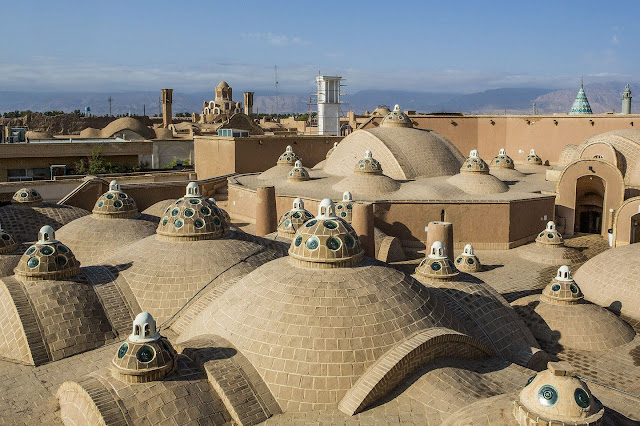The Sultan Amir Ahmad Bathhouse (حمام سلطان امیر احمد), also known as the Ghasemi Bathhouse, is a traditional Iranian public bathhouse in Isfahan province. It is located in Kashan on Sultan Amir Ahmad Street off of Alavi Street. It was constructed in the 16th century during the Safavid era, however, the bathhouse was damaged in 1778 as a result of an earthquake and was renovated during the Qajar era. It underwent further renovations in 1996. The Bathhouse is named after Imamzadeh Sultan Amir Ahmad, whose mausoleum is nearby.
The Sultan Amir Ahmad Bathhouse has an area of approximately 1,000 square meters. It consists of two main parts, the dressing hall (Sarbineh) and the hot bathing hall (Garmkhaneh). Sarbineh is past the main entrance. It is in the shape of a large octagonal hall, which has an octagonal pool in the middle, surrounded by 8 pillars separating its outer sitting area. At the time of construction of the Bathhouse, its intended use was not just to serve cleanliness purposes but rather was a place for rest, gatherings, discussions and even prayers. As a result there are benches surrounding the perimeter of Sarbineh elevated by a few steps above the central pool where visitors can lounge. Garmkhaneh is the main washing area. It consists of hot and cold pools and sitting areas. There are four pillars in Garmkhaneh, which create smaller private bathing rooms all around as well as the entrance to the main bathing room (Khazineh).
The interior of the Bathhouse is decorated with turquoise and gold tilework, plasterwork, brickwork as well as artistic paintings. Most of the decorations of the Bathhouse’s interior are in the Sarbineh area. The temperature in the Sarbineh area is slightly warm in order to avoid a drastic temperature change when entering or exiting the facilities. The area connecting Sarbineh and Garmkhaneh was intentionally designed with multiple turns to minimize the heat and humidity exchange between the two areas. The roof of the bathhouse is made of multiple domes that contain convex glasses to provide sufficient lighting to the Bathhouse while concealing it from the outside. The Bathhouse has other supporting areas as well which were utilized for regulating the amount of water and its temperature.
In the past the Bathhouse has been used as a traditional teahouse although today it serves as a museum. In 1956 the Sultan Amir Ahmad Bathhouse was registered as a national heritage site by Iran’s Cultural Heritage Department.












Thank you Ramin for sharing the 9 photos & descriptive words. Very useful. Another potential World Heritage Site. I think eventually that Iran can earn far more income from ecotourism than from oil, if peace prevails and more of your huge inventory of historical sites are properly recofitted (ecological retrofit). How was the water was heated?
ReplyDeleteDo you know of any bathhouses in an old caravanserai?
Please contact me
I can't claim I'm an expert on carvansarays but I have yet to see one that included a bathhouse. I wish they keep such carvansarays functional, they give out a very nostalgic feel.
ReplyDeleteThis comment has been removed by a blog administrator.
ReplyDeleteThis comment has been removed by a blog administrator.
ReplyDelete